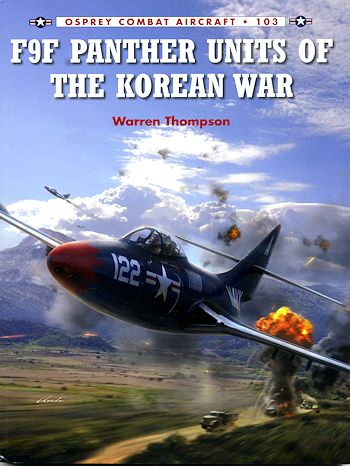 The
first fleet-wide American jet Naval fighter was the F9F Panther. Though the FJ-1
Fury preceded it in terms of carrier use, it was built in very small numbers and
used only by a single fleet squadron. The Panther was pretty much the mainstay
jet for carrier units during the opening phases of the Korean war, though it was
joined later by the F2H Banshee.
The
first fleet-wide American jet Naval fighter was the F9F Panther. Though the FJ-1
Fury preceded it in terms of carrier use, it was built in very small numbers and
used only by a single fleet squadron. The Panther was pretty much the mainstay
jet for carrier units during the opening phases of the Korean war, though it was
joined later by the F2H Banshee.
The Panther racked up several 'firsts' in the Korean war thanks to the
rapidity of which the USS Valley Forge was able to get into action. Just a week
after the North Korean invasion, VF-51 was able to perform the Navy's first jet
combat mission and to shoot down its first enemy aircraft, a Yak-9. The Panther
was pretty much king of the skies over North Korea as the USAF's F-80s did not
have the range to reach deep into North Korea. In truth, were not US carriers
able to operate so close to North Korea, the Panthers wouldn't have been able to
reach many of the targets as jets were very much range hampered due to their
early fuel-thirsty engines. Still, operating off the west coast of North Korea,
they were able to range over the entire country.
When the MiG-15 appeared, it was pretty much the end of the Panther or any
other straight wing jet in terms of air to air combat. It doesn't mean that the
Panther did not snag a MiG from time to time, but the Navy concentrated on
ground attack missions as the US pretty much had air superiority after the first
months of the war. In fact, Royce Williams was able to shoot down four MiG-15s
in one action. Unfortunately for Royce, he was only allowed to officially be
credited with one destroyed and one probable. This was due to the MiGs being
flown from Vladivostok and piloted by Russians. He was told after the action to
say nothing about it for fear of reprisals from the Soviets. In actuality, he
had shot down three in combat and the fourth was so heavily damaged that it
crashed later.
It was not only the Navy that flew Panthers during Korea, but also the
Marines, who flew them with VMF-115 and VMF-311. These units were also flying
the later F9F-4, but due to issues with the -4, requested replacement with older
-2Bs, which was done for the most part, though some units flew both types. The
benefit of these ground based units was that they could carry a larger payload.
Carrier based planes were load limited due to the distances they had to fly, but
Marine units were quite near the front lines so could really load up on
ordnance. In all, 32 USN and USMC squadron deployments occurred during the
Korean war, making the Panther the most widely used Naval jet fighter of the
war.
In this book by author Warren Thompson, each squadron that deployed to Korea
is covered, relating some of the highlights of each cruise. This means quite a
few pilot stories as well as a goodly number of excellent period photo of the
planes and pilots, many of these in full color. In addition, there are several
pages of full color profiles. A list of ship deployments as well as aircraft
losses are included in the appendicies.
If you are an enthusiast of the Korean War or the Panther, then this is a
must have book for you. It is well researched and also reads well. Highly
recommended.
July 2014
For more on the complete line of Osprey books,
visit www.ospreypublishing.com
or contact them at Osprey Direct, PO Box 140, Wellingborough, Northants,
NN8 2FA, UK. In the US, it is
Osprey Direct at 44-02 23rd St, Suite 219, Long Island City, NY 11101., where you can
get a catalogue of available books.
If you would like your product reviewed fairly and
fairly quickly, please
contact the editor or see other details in the
Note to
Contributors.
 The
first fleet-wide American jet Naval fighter was the F9F Panther. Though the FJ-1
Fury preceded it in terms of carrier use, it was built in very small numbers and
used only by a single fleet squadron. The Panther was pretty much the mainstay
jet for carrier units during the opening phases of the Korean war, though it was
joined later by the F2H Banshee.
The
first fleet-wide American jet Naval fighter was the F9F Panther. Though the FJ-1
Fury preceded it in terms of carrier use, it was built in very small numbers and
used only by a single fleet squadron. The Panther was pretty much the mainstay
jet for carrier units during the opening phases of the Korean war, though it was
joined later by the F2H Banshee.